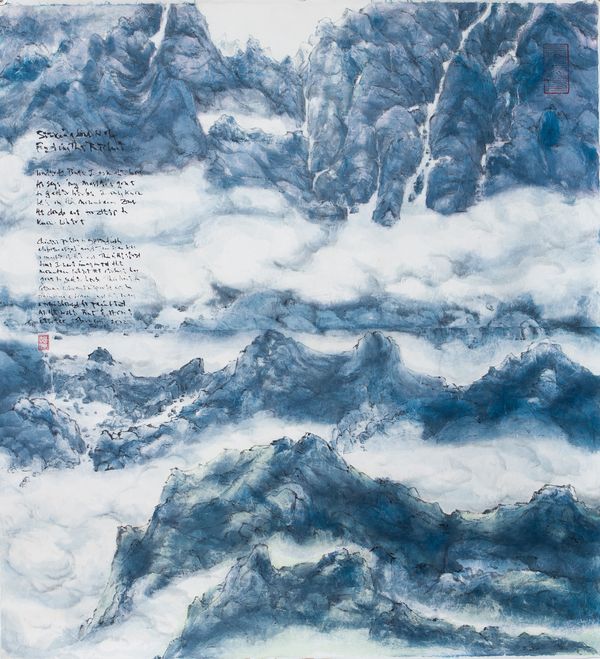The Master of the Water, Pine and Stone Retreat Seeking but not Finding the Recluse, No. 2, 2012
Author, dealer and artist Hugh Moss has had a lifelong obsession with Chinese art. He grew up the son of a prominent London antiquities dealer, and eventually set up his own business in his home city before relocating to Hong Kong. We had the chance to speak with him and learn more about his unique path from leading gallerist to contemporary artist.
The Master of the Water, Pine and Stone Retreat Malachite Gorge, 2014
PHILLIPS: Tell us about how you first became interested in Asian art. Has this been a lifelong preoccupation?
HUGH MOSS: I was brought up surrounded by Chinese art at home, as my father was the London dealer Sydney L. Moss. I joined his company for several years before starting my own gallery in the west end of London. Fascinated by Chinese art, I became a lifelong collector, student and enthusiast.
The Master of the Water, Pine and Stone Retreat Liu Congyuan's Lone Fisherman in the Snow, 2011
P: When did you decide to leave London and settle in Hong Kong? What major differences do you find having lived in both of these major cultural centers?
HM: I left London in 1975, mainly for economic reasons, after the oil crisis and subsequent crash of the art market. My move to Hong Kong came at a time when the center of the Chinese art market was shifting eastward, and Hong Kong rapidly became a fourth major center for Chinese art along with London, Paris and New York. Also with the rapidly shrinking world, and ease of travel, all of these centers were becoming very much more cosmopolitan, blurring many of the distinctions between them that might have been more marked a century earlier. Both London and Hong Kong were culturally very active, the main difference being that in Hong Kong the focus was more on Chinese art, whereas London’s focus was more international. But even that has changed somewhat since.
The Master of the Water, Pine and Stone Retreat The River-borne Censer, 2009
P: What was the transition like from dealer to artist? What did you learn?
HM: Having been a collector and dealer, starting as a teenager, then becoming involved in research into various fields of Chinese art and working closely with auction houses, I had fairly wide experience in the Chinese art world. Starting around 1970, I began to take an interest in living Chinese painters, mostly expatriates, and became a worldwide agent for many of the best of them. Interacting with them, I was excited by the prospect of actually producing art - an aspect of the art world I had not previously considered. I did so initially in order to better understand Chinese painting, but soon became utterly engrossed and, gradually, came to the realization that I could move beyond academic interest to a meaningful contribution.
The Master of the Water, Pine and Stone Retreat Summoning Company, 2012
P: What artists, whether traditional or contemporary, do you most admire?
HM: Being more involved in the Chinese tradition, most of my artistic heroes are drawn from it, and many of them are those I knew closely while acting as their agent and collecting their works. I am, of course, conversant with Western art and particularly impressed by many artists of the last hundred years, along with an appreciation of more ancient art including old master drawings, which have a great affinity with the long-standing Chinese tradition of brush and ink. Some particular favorites among later western artists, drawn from many, are Jackson Pollock, Brice Marden, David Hockney, Egon Schiele, Gustav Klimt and Peter Doig. That is only a selection, there are also many others whose serious and lasting contribution I admire, but whose works do not excite me.
The Master of the Water, Pine and Stone Retreat Cold Pine Torrent Stone, 1993
P: You’re quite prolific as an author, as well. What writing projects do you have on the horizon?
HM: At present, I am working on a sequel to The Art of Understanding Art: a New Perspective, originally published in 2015. Otherwise, I am constantly writing essays and lectures on various aspects of art.





